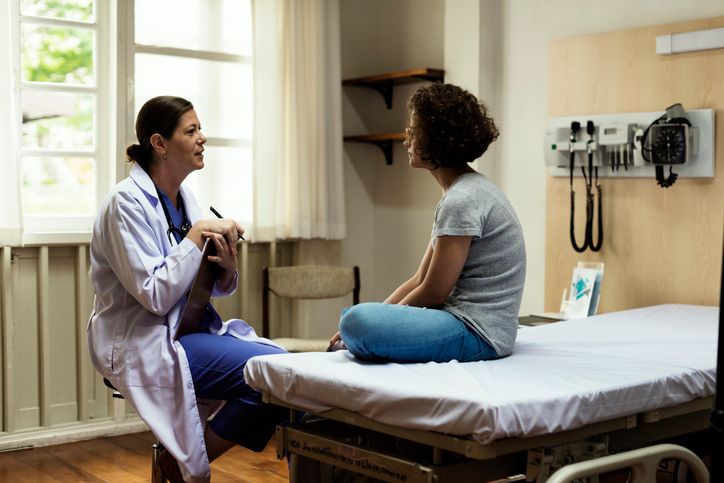


Obstetrician-gynecologists (OB/GYNs) specialize in women’s health—not eating disorders. Yet, because of when and how eating disorders tend to present, and how frequently they go undiagnosed, it’s vital that OB/GYNs become well-versed in spotting and screening for these illnesses among their patients.
Eating disorders are good at hiding, often in plain sight. Some people go to great lengths to keep their behaviors and symptoms a secret, while other behaviors and symptoms (like restrictive eating and compulsive exercise) have become so normalized by diet culture that some people don’t realize they’re a problem. Coupled with the pervasive stereotypes and misinformation about who gets eating disorders, this means that far too many people go undiagnosed. Healthcare providers play a key role in solving this problem and helping detect eating disorders early.
Primary care providers are often on the front lines, but they aren’t the only ones who can help. OB/GYNs also can also be pivotal in helping people get diagnosed and access eating disorder treatment. One reason for this is that it’s common for adolescent and adult females who have eating disorders to experience irregular or absent periods. Another is that many women see these providers every year at their annual women’s wellness checkup (or more often), and this recurrent interaction gives OB/GYNs an opportunity to notice something is wrong and intervene.
“OB/YGNs are seeing patients during pregnancy, postpartum, and menopause,” says Barbara Kessel, DO, CEDS, supervising psychiatrist at Equip. “These are periods when women’s bodies undergo massive changes and could be high-risk times to develop disordered eating.”
Read on to learn eating disorder warning signs OB/GYNs should be on the lookout for, as well as how OB/GYNs can screen and support patients.
The impact of eating disorders on reproductive health
Why is identifying eating disorders in gynecology important? In short, the earlier an eating disorder is detected the better, and eating disorders can often show up in gynecological symptoms before loved ones or other providers notice something is wrong. What’s more, eating disorders can have negative consequences for reproductive health. Let’s look at some of the reproductive health risks associated with eating disorders.
Fertility challenges and pregnancy risks
Malnourishment caused by an eating disorder can affect the hypothalamic-pituitary-ovarian (HPO) axis. When this happens, the brain produces less gonadotropin-releasing hormone (GnRH). This leads to a decrease in the production of luteinizing hormone (LH) and follicle-stimulating hormone (FSH). Without enough LH and FSH, follicles won’t develop, and a woman won’t ovulate or have a period. In turn, this can lead to infertility.
Additionally, women with bulimia nervosa and binge eating disorder are at higher risk of miscarriage, though it’s unclear why.
However, despite common misconceptions, women with eating disorders can and do conceive. So those who don’t wish to become pregnant need education on all contraception options as part of a shared decision-making process.
Decreased bone health and menstrual irregularities
Disruption of the HPO axis often leads to menstrual irregularities, and can play a role in bone health. LH and FSH prompt the ovaries to produce estrogen, which isn’t only a reproductive hormone: estrogen is also necessary for bone growth, maturation, and turnover, or the process where bone tissue is broken down and rebuilt with new tissue. This is why prolonged amenorrhea is linked with low bone mineral density and could eventually lead to osteoporosis.
Although for some time it was believed that hormonal contraceptives, such as birth control pills, help with bone health, scientific evidence shows these medications don’t help and may actually lead to decreased bone density. Instead, weight restoration is recommended.
Using birth control to “treat” amenorrhea is like covering up acne with concealer, Kessel says. “Amenorrhea is a symptom of a problem. The problem is malnourishment,” she explains. “Taking a birth control pill covers up the symptoms of the problem, but it doesn’t treat the problem.”

What are the key red flags of eating disorders in OB/GYN practice?
The different eating disorder diagnoses can present in many different ways, and, on its own, any one sign isn’t a definitive indication of a problem. Still, OB/GYNs should be aware of the following symptoms and ask questions to determine if an eating disorder may be the underlying cause.
Menstrual irregularities
Menstrual disturbances, such as irregular periods and amenorrhea (when periods stop altogether for at least three months), are common in women with eating disorders. “People who are malnourished may not be able to menstruate,” Kessel says. Disordered eating, excessive exercise, and stress can cause changes in hormonal levels that disrupt regular menstruation.
Physical and gynecological symptoms associated with eating disorders
Muscles found throughout the body have estrogen receptors. So if estrogen levels drop due to an eating disorder, it can have wide-ranging effects. It may lead to smaller breasts, atrophic vaginitis (when thinning tissues lead to inflammation of the vagina), and pelvic pain (possibly because decreased estrogen appears to lead to muscle atrophy in the pelvic floor).
Behavioral and psychological indicators
By asking questions, OB/GYNs may pick up on behavioral and psychological symptoms of eating disorders, such as:
- Obsession with food or weight
- Weighing oneself frequently or compulsively
- Concerns about body weight and shape that affect how they feel about themself
- Perfectionism and being self-critical
- Fear or weight gain
- Social withdrawal/preferring to eat alone
- Depression or anxiety
“Malnutrition can cause obsessions, anxiety, and depression,” Kessel explains. “Eating disorders are the second most deadly psychiatric illness, behind opioid abuse, and there’s a high risk of suicide.” So if you think a patient may have an eating disorder, take action to help them.
Our free eating disorder screener can also help you determine if a patient may have an eating disorder.
How OB/GYNs can screen for eating disorders in their practice
The red flags above are an indication to investigate further whether a patient may have an eating disorder. To work to identify potential eating disorders in gynecology patients, it helps to use screening tools, physical exams, and sometimes lab work.
Practical screening questions and tools
Basic, open-ended questions such as “How do you feel about your weight?” or “What does a typical day of eating look like for you?” may lead to a deeper conversation that sheds light on disordered eating patterns.
Additionally, there are a number of clinically validated tools that can help providers screen for eating disorders. Two of the most widely used are the SCOFF questionnaire and the Eating disorder Screen for Primary care (ESP).
The SCOFF questionnaire consists of five questions. If a patient answers “yes” to two or more questions, it indicates the likely presence of anorexia or bulimia. The questions are:
- Do you make yourself Sick because you feel uncomfortably full?
- Do you worry that you have lost Control over how much you eat?
- Have you recently lost more than One stone (14 pounds) in a three-month period?
- Do you believe yourself to be Fat when others say you are too thin?
- Would you say that Food dominates your life?
The ESP questionnaire also consists of five questions. A “no” to the first question and “yes” to the other questions are considered abnormal responses, and any abnormal response indicates a need for further assessment. The questions are:
- Are you satisfied with your eating patterns?
- Do you ever eat in secret?
- Does your weight affect the way you feel about yourself?
- Have any members of your family suffered with an eating disorder?
- Do you currently suffer with or have you ever suffered in the past with an eating disorder?
Physical examination and laboratory tests
Questions can help OB/GYNs get at the psychological aspect of eating disorders, but a complete evaluation also involves looking for physical signs. In addition to asking about menstrual history, OB/GYNs should conduct a complete physical exam, and potentially order lab work.
When conducting a physical exam, some signs to look out for include::
- Swollen salivary glands
- Calluses on the knuckles
- Dental decay
- Languo, or soft, downy hair all over the body
- Bradycardia, or a slow heart rate
- Weight loss or falling off the growth curve
Although lab work isn’t always part of an OB/GYN exam, if you suspect that a patient might have an eating disorder, it can be helpful to order some tests. Common indicators of eating disorders that might show up in lab work include electrolyte imbalances, anemia, low potassium levels, and thyroid dysfunction. These results can also help rule out other possible diagnoses.
In addition, OB/GYNs may consider ordering tests to check bone density. Kessel says that if somebody has lost their period for at least six months, it’s fairly common to order a DXA scan, an x-ray test that measures bone mineral density. Low bone density, which can be a result of malnutrition, puts people at risk of developing osteopenia or even osteoporosis.

Best practices for OB/GYNs: supporting patients with eating disorders
If you think you spot eating disorder symptoms in your OB/GYN practice, the best thing to do is open the door to a conversation, Kessel advises. “If you don’t ask the screening questions, people aren’t going to tell you,” she says.
Before you begin talking, keep the following in mind.
Create a supportive and non-judgmental environment
It’s essential to be non-judgmental about any disordered behaviors or thoughts someone mentions. This helps create a safe space and makes patients more inclined to continue the discussion. “Talk about how eating disorders are pretty common, educate them about the risks, and normalize getting help,” Kessel says. Being empathetic and validating their experience can go a long way toward helping them open up.
At the same time, Kessel recommends avoiding any focus on a patient’s weight, body size, or dieting. It’s also best to avoid weighing patients unless absolutely necessary, since doing so may be triggering. If you must weigh patients for any reason, offer a blind weight (when a patient turns so they don’t see the number). Providers should also be careful not to inadvertently reinforce or celebrate disordered behaviors (like restrictive eating or compulsive exercise) or weight loss.
Collaborate with multidisciplinary teams
While OB/GYNs play a key role in identifying eating disorders in patients, they can’t be expected to provide treatment. In order to best support patients, OB/GYNs should develop relationships with therapists, dietitians, and other medical providers who specialize in eating disorders. This kind of collaborative, multidisciplinary approach has been shown to lead to the best treatment outcomes for patients with eating disorders. “Know what resources are available in your community, and create a referral list of experts,” Kessel suggests. There is also virtual treatment (like Equip), which research shows is as effective as in-person eating disorder treatment. Equip offers evidence-based eating disorder treatment for patients of all ages and all diagnoses in all 50 states.
Lastly, if someone shows any of the following signs, they should be hospitalized for medical stabilization:
- Very low weight (<75% of the 50th percentile BMI for age and sex)
- Dehydration
- Electrolyte disturbance (low potassium, sodium, phosphorus)
- Severely low heart rate (<50 beats/minute daytime; <45 beats/minute sleeping)
- Abnormally low blood pressure
- Low body temperature (<95 degrees F, <35.6 degrees C)
- Orthostatic changes in pulse or heart rate
- Dehydration
- Arrested growth and development
- Uncontrollable binging and purging
- Medical complications of malnutrition
- Concurrent medical or psychiatric conditions that limit appropriate outpatient treatment
Learn more about when to refer a patient to eating disorder treatment and how to know if a patient needs inpatient hospitalization.
The Equip takeaway: OBGYNs can help women get the care they need
OB/GYNs are in a unique position to help recognize signs of eating disorders in their patients and support them in getting proper treatment. Many, though not all, women with eating disorders experience gynecological symptoms, and it’s common for this population to get an annual women’s wellness exam, putting OB/GYNs in a position to notice concerning signs of trends over time.
By asking nonjudgmental questions, knowing eating disorder screening tools, and performing a complete physical examination, OBGYNs can help identify potential eating disorders in their patients that might go unnoticed otherwise.
At the same time, OBYGNs are not experts in eating disorders. They need to have a working knowledge of these conditions so they can identify red flags, and they should also develop relationships with eating disorder professionals to whom they can refer patients. With a deeper understanding of eating disorders and how they might show up in a gynecological setting, OB/GYNs can play a vital role in early eating disorder intervention and be part of a multidisciplinary team that supports recovery.
If you’re concerned that a patient of yours has an eating disorder, it’s important to connect them to eating disorder professionals who can help. Schedule a call with our team to talk through your concerns or begin a referral.
FAQs
What are the early signs of eating disorders that OB/GYNs should look for?
The early signs of eating disorders are often subtle. Still, OB/GYNs may be able to detect warning signs by asking open-ended questions about the person’s eating behaviors, physical activity, and self-esteem. If a person mentions frequently checking their weight or thinking about what they’re eating, new or uncommon eating or exercise behaviors, or avoiding social situations that involve food, these may be warning signs.
How do eating disorders affect menstrual cycles and reproductive health?
Eating disorders can lead to irregular periods, amenorrhea (no periods for three months or longer), infertility, miscarriage, and pregnancy complications.
What should an OB/GYN do if they suspect a patient has an eating disorder?
If an OB/GYN suspects a patient has an eating disorder, they should ask questions and perform a physical examination that can help determine whether an eating disorder is present. They should be empathetic and nonjudgmental, and normalize seeking treatment. It’s also essential to refer patients to virtual or in-person eating disorder specialists who can help them get the support they need to recover.
When is hospitalization necessary for patients with eating disorders?
According to the Society for Adolescent Health and Medicine, hospitalization may be needed if a person presents with one or more of the following:
- Electrolyte disturbance (low potassium, sodium, phosphorus)
- Very low weight (<75% of the 50th percentile BMI for age and sex)
- Severely low heart rate (<50 beats/minute daytime; <45 beats/minute sleeping)
- Abnormally low blood pressure
- Low body temperature (<95 degrees F, <35.6 degrees C)
- Orthostatic changes in pulse or heart rate
- Dehydration
- Arrested growth and development
- Uncontrollable binging and purging
- Medical complications of malnutrition
- Concurrent medical or psychiatric conditions that limit appropriate outpatient treatment
Why is a multidisciplinary approach important for treating eating disorders?
A multidisciplinary approach is important for treating eating disorders because eating disorders affect a person’s mind, body, and life. A team of experts, such as medical providers, therapists, dietitians, and more, can address all aspects of the eating disorder and work together to provide the support a person needs to recover. This is also the most effective approach for weight restoration, according to research.
- Kimmel, MC et al. “Obstetric and Gynecologic Problems Associated with Eating Disorders.” International Journal of Eating Disorders vol. 49,3 (2015):260-275. doi:10.1002/eat.22483
- Holesh, Julie E et al. “Physiology, Ovulation.” StatPearls [Internet]. StatPearls Publishing; 2023. PMID: NBK441996.
- “Gynecologic Care for Adolescents and Young Women With Eating Disorders.” American College of Obstetricians and Gynecologists Committee Opinion No. 740: 2018. https://www.acog.org/clinical/clinical-guidance/committee-opinion/articles/2018/06/gynecologic-care-for-adolescents-and-young-women-with-eating-disorders
- Väänänen, HK and Härkönen, PL. “Estrogen and bone metabolism.” Maturitas vol. 23 (1996):S65-9. doi:10.1016/0378-5122(96)01015-8
- Indirli, Rita et al. “Bone health in functional hypothalamic amenorrhea: What the endocrinologist needs to know.” Frontiers in Endocrinology vol. 13 (2022). doi:10.3389/fendo.2022.946695\
- De Sanctis, Vincenzo et al. “Current Issues and Options for Hormonal Contraception in Adolescents and Young Adult Women With Sickle Cell Disease: An Update for Health Care Professionals.” Mediterranean Journal of Hematology and Infectious Diseases vol. 12,1 (2020):e2020032. doi:10.4084/MJHID.2020.032
- Bergström, Ingrid et al. “Women with anorexia nervosa should not be treated with estrogen or birth control pills in a bone-sparing effect.” Acta Obstetricia et Gynecologica Scandinavica vol. 92,8 (2013):877-80. doi:10.1111/aogs.12178
- Zhuo, Zhihong et al. “The Relationship Between Pelvic Floor Function and Sexual Function in Perimenopausal Women.” Sexual Medicine vol. 9,6 (2021):100441. doi:10.1016/j.esxm.2021.100441
- Morgan, John f et al. “The SCOFF questionnaire.” Western Journal of Medicine vol. 172,3 (2000):164-165. doi:10.1136/ewjm.172.3.164
- Cotton, Mary-Anne et al. “Four Simple Questions Can Help Screen for Eating Disorders.” Journal of General Internal Medicine vol. 18,1 (2003):53-56. doi:10.1046/j.1525-1497.2003.20374.x
- “Medical Management of Restrictive Eating Disorders in Adolescents and Young Adults.” The Society for Adolescent Health and Medicine. (2022). doi:10.1016/j.jadohealth.2022.08.006
- Woodruff, Kary et al. “A Retrospective Chart Review Suggests That Coordinated, Multidisciplinary Treatment for Patients with Anorexia Nervosa Improves Odds of Weight Restoration.” Journal of Multidisciplinary Healthcare vol. 17 (2024):339-351. doi:10.2147/JMDH.S437376







